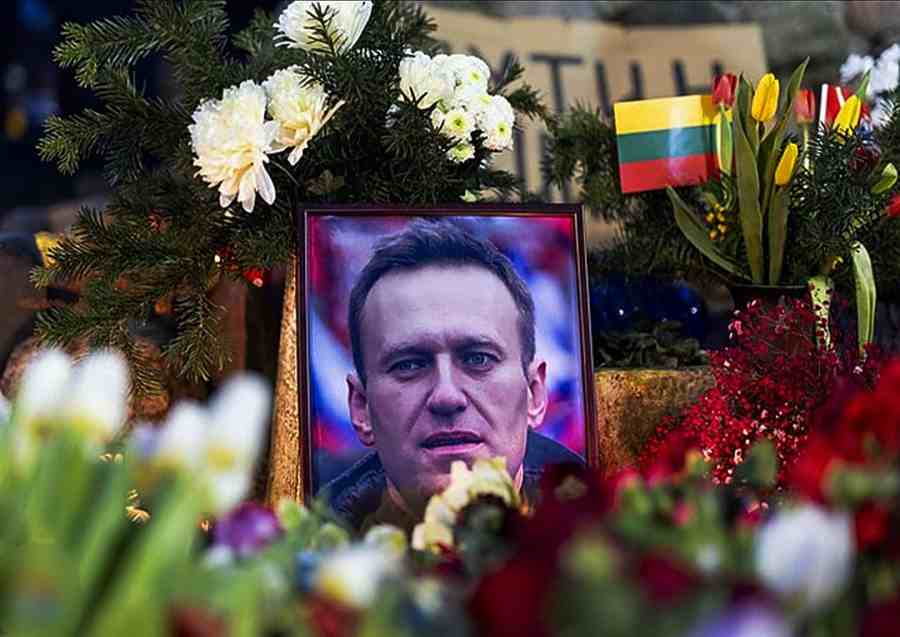![]() Photos of Russian opposition leader Alexey Navalny, with flowers and candles, are laid on a ground in front of the Russian embassy in Vilnius, Lithuania, on Friday, February 16, 2024
Photos of Russian opposition leader Alexey Navalny, with flowers and candles, are laid on a ground in front of the Russian embassy in Vilnius, Lithuania, on Friday, February 16, 2024
Mon 19 February 2024:
In the last known video of Alexey Navalny shot one day before his death on Friday, the lanky, fair-haired 47-year-old looks gaunt and cracks jokes.
Navalny was filmed via a video link from the IK-3 penal colony, also known as the Polar Wolf prison, in the Arctic town of Harp during a video conference with a judge in the city of Vladimir some 600 kilometres south.
“I want you to replenish my [prisoner] account from your huge salary of a federal judge,” Navalny, clad in a black prison uniform, said, laughing sarcastically from behind bars, according to the grainy video.
A day later, Russian President Vladimir Putin’s most outspoken opponent fainted and fell after a walk, and was pronounced dead two hours later, despite “numerous resuscitation attempts,” prison officials said.
The cause of death is “being established,” they said.
The Kremlin-funded RT television channel claimed he had a blood clot, but Navalny’s supporters, Kremlin critics and observers were unanimous in claiming that he had been murdered.
“They killed him. Even if not on that very day, several years of torture is also a way of killing,” Sergei Biziukin, a fugitive opposition activist from the western city of Ryazan, told Al Jazeera.
“Of course, this is a murder. He had been tortured to death for years,” Gennady Gudkov, a former intelligence officer turned opposition leader, told Al Jazeera.
Navalny’s deputy blamed Putin for Navalny’s “murder.”
“Specifically, it was Putin who killed him,” Ivan Zhdanov, who replaced Navalny as head of the Fund to Fight Corruption, a group that exposed corruption, worked with opposition activists and once had branches throughout Russia, said in a video.
For more than three years, Navalny was locked in several Russian jails – where he complained of severe back pain that made his feet numb and of “torture with insomnia” because of constant bright light in his cell.
Of the 37 months of his prison time, he spent 296 days in solitary confinement in box-like concrete cells where prisoners are not allowed to lie down during the day and can only sit on a bench that is 14 centimetres high and has no back to lean upon, his lawyers said.
“Navalny died as a result of murder – a premeditated murder, a methodically executed murder, a murder the Russian state is to blame for,” OVD Info, a human rights group that has been monitoring arrests and persecution of Kremlin critics, said in a statement late on Friday.
“There’s no need to poison or kill him in some other violent way – one just has to wait,” it said.
But Navalny was previously poisoned.
In July 2019, he was hospitalised with an “acute allergic reaction,” swellings and a rush, Russian medical doctors said, but never released the cause.
Navalny and his personal doctor said he had no allergies and the “reaction” was caused by an unspecified poison.
A year later, while on a plane over Siberia, he collapsed, fell into a coma and was rushed to a hospital after an emergency landing and then flown to a German clinic.
A conclave of German experts concluded Navalny had been poisoned with a rare and expensive nerve agent from the Novichok family of toxins developed in the USSR.
Navalny’s team and independent reporters said they had identified the purported poisoners, a group of Russian intelligence officers, and Navalny called one of them pretending to be a security official.
The officer, identified as Konstantin Kudryavtsev, told him the nerve agent was applied to the politician’s underwear, according to their conversation’s recording Navalny released. The Kremlin denied those claims.
After months of rehabilitation in Germany, he returned to Russia, was immediately arrested and stood several trials that his supporters, rights groups and Western governments called Kremlin-orchestrated.
He was serving three sentences, including a 19-year prison term for “extremism,” but remained the biggest thorn in Putin’s side. Despite arrests and emigration of its members, his Fund to Fight Corruption kept releasing investigative reports detailing corruption in the Kremlin halls of power.
Navalny remained active on social media with sarcastic posts ridiculing Putin and calling his full-scale invasion of Ukraine a “nightmare”.
His last Facebook post was dated February 14, Valentine’s Day, and addressed his wife Yulia “whom he loved more and more”.
Even though Putin amended Russia’s constitution to “nullify” his previous terms and run for re-election in March 2024, analysts believe that he saw Navalny as one of the biggest threats to his power. In a February 1 post on Facebook, Navalny urged Russians to show up at polling stations “exactly at noon” to vote against Putin.
“Navalny’s death, unfortunately, was predictable from the moment he took a plane to Moscow,” Nikolay Mitrokhin of Germany’s Bremen University told Al Jazeera.
His death embodies the totalitarian practices that evolved under Putin and resembles those of Soviet dictator Joseph Stalin, he said. “Today’s Russia is not even South Africa of the 1960s. One can’t leave prison the way [apartheid critic Nelson] Mandela did,” Mitrokhin said.
“Here, they kill in prison. Especially the bright and unbreakable ones.”
The reported cause of death looks suspicious, according to health professionals.
A reanimation expert who had helped Navalny recover from the 2020 poisoning, said that the RT television channel’s claim that Navalny died of a blood clot is false.
“To diagnose it, there has to be an examination of the living [patient] that, as we know, has not been conducted,” Alexander Polupan told The Insider, an independent online magazine, late on Friday. “Or such a diagnosis is made according to the results of an autopsy” that has not been conducted yet.
“That’s why making such a diagnosis is like pointing a finger in the sky,” he was quoted as saying. “It is surprising a propaganda [ media outlet] had this version ready.”
A former prison official turned human rights activist claimed that prison doctors often resort to the “blood clot” diagnosis to describe suspicious causes of death.
“This is a universal diagnosis that is hard to prove and somewhat useful,” Anna Karetnikova was quoted by the Meduza publication as saying.
______________________________________________________________
FOLLOW INDEPENDENT PRESS:
WhatsApp CHANNEL
https://whatsapp.com/channel/0029VaAtNxX8fewmiFmN7N22
![]()
TWITTER (CLICK HERE)
https://twitter.com/IpIndependent
FACEBOOK (CLICK HERE)
https://web.facebook.com/ipindependent
Think your friends would be interested? Share this story!





